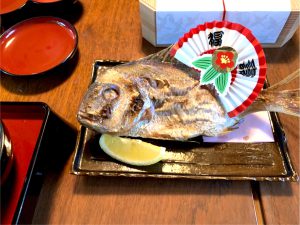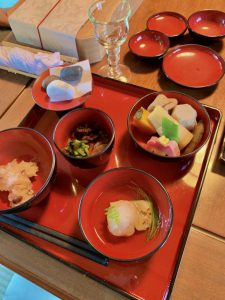お食い初め(愛知県名古屋市千種区姫池通 骨董買取いたします 古美術風光舎名古屋店)
2022.05.13
皆さま、こんにちは。スタッフMです。
週末にかけて雨ということで、気分もブルーになってしまいそうな今日、皆さまいかがお過ごしでしょうか。
今回のブログでは少しでも晴れた気持ちになれるよう(最近の出来事を話したいだけです)お食い初めについてお話させていただきます。
というのも実は先週、姪っ子の「お食い初め」を行いました。私自身、初の行事ということで、とても楽しみにしていた行事の1つなのです。
簡単にお食い初めについて説明させていただきますと、お食い初めは「100日祝い」「百日祝い」とも呼ばれる生後100日のお祝い事です。
平安時代から行われている、歴史のある伝統行事で”一生、食べることに困らないように”と赤ちゃんの健やかな成長を願って行われます。
お食い初めでは初めて箸を使ってお魚を食べさせる真似をすることから「箸揃え」「箸祝い」「真魚始め(まなはじめ)」とも呼ばれるそうです。
このように地域によっても色々な呼び方で呼ばれていますが、赤ちゃんが数か月間無事に成長してきたことを家族でお祝いし、感謝するという意味合いは変わりません。
お食い初めの起源や由来は、平安時代に遡り、赤ちゃんにお餅を食べさせる「百日(ももか)」という行事があり、これがお食い初めの始まりと言われています。
最初は、生後50日に行われていたので「五十日(いのか))の祝い」といわれ、食べさせるお餅を「五十日餅(いのかもち)」と呼んでいました。重湯の中にお餅を入れ、そのお餅を赤ちゃんの口に少しだけ含ませるというものでした。やがて五十日のお祝いが百日になり、鎌倉時代には餅から魚肉に変わり、「真魚初め」と呼ばれるようになりました。
昔は衛生面や栄養面も良くなく、無事に育つことが難しかったので、様々な節目で赤ちゃんの成長を祈る儀式やお祝いが行われてきました。そして歴史を重ね、生後100日頃にお祝い膳をこしらえ、お祝いするという伝統が現代に伝わっているそうです。
お祝い膳は、日本古来の献立「一汁三菜」が基本とされています。鯛など尾頭つきの魚と、赤飯、吸い物、煮物、香の物が献立となります。また、生後100日前後は、早い子ですと乳歯が生え始めることから、「歯固めの石」を用意し、丈夫な歯が生えるようにという願いを込めます。
献立の内容は、地域で特色も多く、地方ごとの名産物が加えられたりと様々。
北海道では小豆ではなく甘納豆を入れてお赤飯を炊くことが定着していたり、大阪などでは「多幸」という語呂合わせから、縁起の良い食べ物とされ歯固めの石の代わりにタコを使う場合もあるそうです。
地域によっては、歯固めの石として他に「梅干し」「栗の実」「紅白餅」などを使ったり、九州地方では漆塗りの食器の代わりに松竹梅と鶴亀の絵が描かれた「ポッポ膳」と呼ばれる食器を使用したりもするそうです。
地域によっていろいろな形のお食い初めがあり、それだけでも面白く興味深いですね。
今回姪っ子のお祝い膳はスタンダードなもので、鯛、赤飯、吸い物、煮物、香の物という献立と、歯固めの石が用意されていました。


普段はミルクしか飲まない姪っ子ですが、その日は口に赤飯を運ばれるとおっきくあけて食べようとしていたのがとても可愛らしかったです。
お食い初めは地域にとっても違いますが、国によっても祝い方が様々あります。
次回は、世界のお食い初めについても調べてみたいと思います。
Hello everyone. This is Staff M.
How are you doing today, when it’s raining over the weekend and you’re feeling blue? In this blog, I will talk about the beginning of eating so that I can feel a little clearer (I just want to talk about recent events).
Actually, last week, I had a niece’s “beginning to eat”. It’s one of the events I’ve been looking forward to because it’s my first event.
To briefly explain the beginning of eating, the beginning of eating is a celebration of the 100th day after birth, which is also called “100th day celebration” or “100th day celebration”. It is a traditional event that has been held since the Heian period, and is held in the hope that the baby will grow up healthy, saying, “Don’t worry about eating for the rest of your life.”
At the beginning of eating, they use chopsticks to imitate eating fish for the first time, so they are also called “chopsticks alignment,” “chopsticks celebration,” and “mao beginning.” In this way, it is called in various ways depending on the region, but the meaning of celebrating and thanking the family for the successful growth of the baby for several months does not change.
The origin and origin of the beginning of eating goes back to the Heian period, and there is an event called “Momoka” that feeds babies with rice cakes, and this is said to be the beginning of eating. At first, it was held on the 50th day after birth, so it was said to be a “celebration of the fifty days”, and the rice cakes to be eaten were called “fifty days mochi”. The idea was to put rice cakes in heavy water and add a little of the rice cakes to the baby’s mouth. Eventually, the celebration of the fifty days became the hundredth day, and in the Kamakura period, rice cakes changed to fish meat, and it came to be called “Mao Hajime”. In the past, hygiene and nutrition were not good, and it was difficult to grow up safely, so ceremonies and celebrations were held at various milestones to pray for the growth of the baby. It is said that the tradition of celebrating with a festive set around 100 days after birth has been handed down to the present day.
The celebration set is based on the traditional Japanese menu “Ichiju Sansai”. Fish with tails such as sea bream, red rice, soup, simmered dishes, and pickles are on the menu. Also, around 100 days after birth, if you are an early child, milk teeth will start to grow, so prepare a “tooth-hardening stone” and hope that strong teeth will grow.
The contents of the menu have many characteristics in each region, and there are various things such as the addition of local specialties. In Hokkaido, it is common to cook red rice with sweet natto instead of azuki beans, and in Osaka etc., it is said that octopus is used instead of hardened stones because it is considered to be auspicious food because of the wordplay “Takou”. is. Depending on the area, other stones such as “umeboshi”, “chestnut fruit”, and “red and white rice cake” may be used, and in the Kyushu region, “Poppo” with a picture of Shochikuume and Tsurugame instead of lacquered tableware. They also use tableware called “zen”.
There are various forms of eating beginnings depending on the region, and that alone is interesting and interesting. This time, the niece’s festive set was standard, with menus such as sea bream, sekihan, soup, simmered dishes, and pickles, as well as tooth-hardening stones.
My niece usually drinks only milk, but on that day, when she brought red rice to her mouth, she opened it up and tried to eat it, which was very cute. The beginning of eating is different for each region, but there are various ways to celebrate depending on the country. Next time, I would like to find out about the beginning of eating in the world.
*********************
風光舎では、古美術品や骨董品の他にも絵画や宝石、趣味のお品など様々なジャンルのものを買受しております。
お片付けをされていて、こういうものでもいいのかしらと迷われているものでも、どうぞお気軽にご相談下さいませ。
また風光舎は、出張買取も強化しております。
ご近所はもちろん、愛知県内、岐阜県、三重県その他の県へも出張いたします。
まずは、お電話お待ちしております。
愛知県名古屋市千種区・骨董 買取
『古美術 風光舎 名古屋店』
TEL 052(734)8444
10:00-17:00 OPEN

